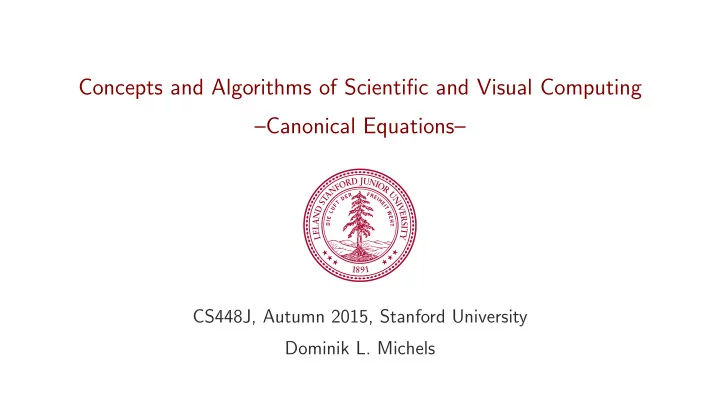

Concepts and Algorithms of Scientific and Visual Computing –Canonical Equations– CS448J, Autumn 2015, Stanford University Dominik L. Michels
Hamiltonian Formalism The Euler-Lagrange formalism can be seen as the entrance to modern mechanics based on variational principles. A closely related point of view is given by the Hamiltonian formalism leading to the so-called canonical equations. In contrast to the Euler-Lagrange equations, instead of coordinates and velocities, the canonical equations describe coordinates and momenta for which reason they are appropriate for the geometric interpretation of the dynamics in the phase space U .
Legendre Transformation A Legendre transformation converts a differentiable function f : R 2 ⊃ D ∋ ( x , y ) �→ f ( x , y ) ∈ R into a function g : D ∋ ( u , y ) �→ g ( u , y ) ∈ R with an independent variable u := ∂ x f . By definition, the function g is given by g ( u , y ) := ∓ ( f ( x ( u ) , y ) − ux ( u )) and the inverse of the Legendre transformation is defined via f ( x , y ) := ± ( xu ( x ) − g ( u ( x ) , y )) with x := ± ∂ u g .
Legendre Transformation f(x,y) = g( Δ y/ Δ x,y)+x·( Δ y/ Δ x) f(x 0 ,y 0 ) Δ f 0 Δ x 0 g( Δ f 0 / Δ x 0 ,y 0 ) x 0 Figure : Geometric interpretation of the Legendre transformation: instead of describing the graph of the function f by its curve, one can characterize f by the set of all tangents, which enfold the curve. The function g maps the slope u of a tangent to its ordinate intercept.
Hamiltonian Formalism The Hamiltonian formalism can be seen as the counterpart of the Euler-Lagrange formalism. They are connected by the Legendre transformation. For the derivation of the Hamiltonian formalism we are searching for the function H : ( p , q , t ) �→ H ( p , q , t ) which follows from the application of the Legendre transformation on the Lagrange function L : ( q , ˙ q , t ) �→ L ( q , ˙ q , t ) . Using the canonical multidimensional generalization of the Legendre transformation, we obtain the so-called Hamiltonian N � H ( p , q , t ) = ( p i ˙ q i ) − L ( q , ˙ q , t ) (1) i =1 with ˙ q = ˙ q ( p , q ) and the canonical momenta p i = ∂ ˙ q i L for i ∈ { 1 ,..., N } .
Hamiltonian Formalism Its derivation trivially reads N � � � d H = ∂ p i ( H )d p i + ∂ q i ( H )d q i + ∂ t ( H )d t (2) i =1 and on the other hand according to the definition Eq. (1) of the Hamiltonian we obtain N � � � d H = p i d˙ ✿✿✿✿ + ˙ q i q i d p i − ∂ q i ( L )d q i − ∂ ˙ q i ( L )d˙ q i − ∂ t ( L )d t ✿✿✿✿✿✿✿✿✿ i =1 N � � � = q i d p i − ˙ ˙ p i d q i − ∂ t ( L )d t . (3) i =1 Equating coefficients of Eq. (2) and Eq. (3) leads to the canonical equations q i = ∂ p i H , ˙ p i = − ∂ q i H . ˙ (4) Furthermore by equating coefficients we obtain the connection ∂ t L + ∂ t H = 0 of the temporal derivatives of the Lagrangian and the Hamiltonian.
Hamiltonian Formalism The applications of the Hamiltonian formalism works similar to the one of the Euler-Lagrange formalism: after setting up the Hamiltonian, the equations of motions follow by the substitution of the Hamiltonian into the canonical equations. The Euler-Lagrange formalism leads for a system with N degrees of freedom to N differential equations of second order. In contrast, the Hamiltonian formalism leads to 2 N differential equations of first order. The resulting equations are equivalent descriptions of the physical system and can be easily transformed into each other.
Harmonic Oscillator The one-dimensional harmonic oscillator can be described by the Lagrangian q , t ) = 1 q 2 − 1 2 kq 2 (= T − V ) . L ( q , ˙ 2 m ˙ Substitution into the Euler-Lagrange equation d t ∂ ˙ q L − ∂ q L = 0 directly leads to the second order equation of motion m ¨ q + kq = 0. On the other hand, the Hamiltonian is given by = p 2 � 1 q 2 − 1 2 m + c 2 kq 2 � 2 q 2 (= T + V ) H ( p , q , t ) = p ˙ 2 m ˙ q − with the so-called conjugate momentum p := ∂ ˙ q L = m ˙ q . Substitution into q = ∂ p H , ˙ p = − ∂ q H ˙ leads to the first order equations of motion q = p ˙ m , p = − kq . ˙ By derivation follows their equivalence to the second order equation m ¨ q + kq = 0.
Recommend
More recommend